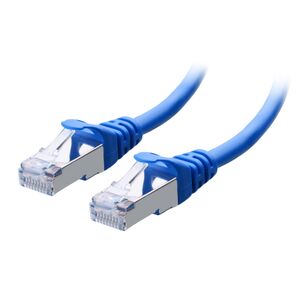We are still actively working on the spam issue.
Difference between revisions of "Home Server/Networking/Ethernet"
(Created page with "Ethernet cables come in different types, each designed for specific networking and data transfer needs. Cat 5e supports up to 1 Gbps at 100 meters. This is the standard choic...") |
(→Ethernet CAT Specs) |
||
| (4 intermediate revisions by the same user not shown) | |||
| Line 1: | Line 1: | ||
| − | Ethernet | + | [[Category:Home Server]] |
| + | [[File:Cat6a.jpg|thumb|right|A cat 6a Ethernet cable. Notice the shielded plating?]] | ||
| − | + | Companion page to [[Home_server#Ethernet|the Ethernet section on the Home Server page]]. | |
| − | '' | + | ==Ethernet CAT Specs== |
| + | '''Cat 5:''' This is an older type of Ethernet cable, capable of supporting up to 100 Mbps at 100 meters. It's not commonly used today due to its lower speed capabilities. | ||
| − | + | '''Cat 5e:''' An enhanced version of Cat 5, it supports up to 1 Gbps at 100 meters. It's designed to reduce crosstalk, i.e., interference from adjacent wires. It's a common choice for home networks. | |
| + | '''Cat 6:''' This cable supports up to 1 Gbps at 100 meters or 10 Gbps at shorter distances (up to 55 meters). It has better insulation to reduce crosstalk and is suitable for business networks. | ||
| − | + | '''Cat 6a:''' An augmented version of Cat 6, it supports 10 Gbps at 100 meters. It has even better insulation to reduce crosstalk. | |
| − | + | ||
| − | + | '''Cat 7:''' This cable supports up to 10 Gbps at 100 meters and has a higher frequency of 600 MHz. It uses a modified GigaGate45 connector, which is backward compatible with RJ45 Ethernet ports. | |
| − | + | ||
| − | + | '''Cat 7a:''' An augmented version of Cat 7, it supports up to 10 Gbps at 100 meters and has a higher frequency of 1000 MHz. | |
| − | + | ||
| − | + | '''Cat 8:''' The latest and fastest Ethernet cable, it supports up to 25 Gbps or 40 Gbps at distances up to 30 meters. It's primarily used in data centers where high-speed connections are required. | |
| − | |||
Latest revision as of 05:05, 20 February 2024
Companion page to the Ethernet section on the Home Server page.
Ethernet CAT Specs
Cat 5: This is an older type of Ethernet cable, capable of supporting up to 100 Mbps at 100 meters. It's not commonly used today due to its lower speed capabilities.
Cat 5e: An enhanced version of Cat 5, it supports up to 1 Gbps at 100 meters. It's designed to reduce crosstalk, i.e., interference from adjacent wires. It's a common choice for home networks.
Cat 6: This cable supports up to 1 Gbps at 100 meters or 10 Gbps at shorter distances (up to 55 meters). It has better insulation to reduce crosstalk and is suitable for business networks.
Cat 6a: An augmented version of Cat 6, it supports 10 Gbps at 100 meters. It has even better insulation to reduce crosstalk.
Cat 7: This cable supports up to 10 Gbps at 100 meters and has a higher frequency of 600 MHz. It uses a modified GigaGate45 connector, which is backward compatible with RJ45 Ethernet ports.
Cat 7a: An augmented version of Cat 7, it supports up to 10 Gbps at 100 meters and has a higher frequency of 1000 MHz.
Cat 8: The latest and fastest Ethernet cable, it supports up to 25 Gbps or 40 Gbps at distances up to 30 meters. It's primarily used in data centers where high-speed connections are required.
